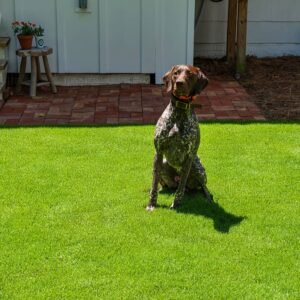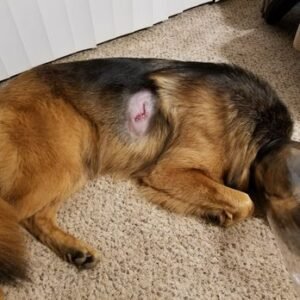Keep dogs off new sod for at least 2 to 3 weeks. This allows the roots to establish firmly. So let jump in deep: How Long to Keep Dogs off New Sod?
Introducing new sod to your lawn can transform its appearance, but it requires careful attention. One crucial aspect is ensuring your pets, especially dogs, stay off the new grass. Dogs can cause damage by digging, running, and urinating on the fresh sod.
This can hinder root development and lead to patchy growth. To achieve a lush, healthy lawn, create barriers or supervise your pets closely. Gradually reintroduce them to the area once the sod is well-rooted. This proactive approach will help maintain the integrity of the new sod and ensure a beautiful, green lawn for years to come.
Introduction To New Sod And Pets: How Long to Keep Dogs off New Sod
Introducing new sod to your lawn is exciting. But if you have pets, it can be a challenge. Dogs love to play and dig. Fresh sod needs time to establish. Understanding how pets affect new sod is crucial. Let’s explore the care needed for new sod and the impact of pets.
Why New Sod Needs Care
New sod is delicate. It needs special attention to root properly. Without proper care, the sod may not establish. Here are some reasons why new sod needs care:
- Watering: New sod needs regular watering to grow roots.
- Soil Contact: Roots need to connect with the soil.
- Foot Traffic: Too much walking can damage new sod.
- Sunlight: Adequate sunlight helps the grass grow.
Impact Of Pets On Fresh Sod
Pets can impact new sod negatively. Dogs, in particular, can cause several issues. Here are some ways pets affect new sod:
| Impact | Details |
|---|---|
| Digging: | Dogs love to dig, which can uproot new sod. |
| Running: | Running can create patches and uneven areas. |
| Urine: | Dog urine can burn the grass, causing yellow spots. |
| Chewing: | Some dogs chew on the sod, damaging the grass. |
To ensure your new sod thrives, keep pets off it initially. Proper care helps the sod establish strong roots. This makes your lawn lush and beautiful.
Initial Sod Installation
Installing new sod in your yard can transform its look. It’s crucial to ensure the installation process is done right. This helps the sod to root properly and grow healthy. Below are the steps involved in the initial sod installation.
Preparing Your Yard
Before laying sod, you need to prepare your yard. This involves several tasks:
- Clear the area of any debris, rocks, or old grass.
- Level the soil to ensure a smooth surface.
- Add compost or soil amendments to enrich the soil.
- Water the soil lightly to moisten it before laying sod.
Proper preparation helps the sod to root quickly. It also prevents uneven growth and patches.
Laying The Sod
Once the yard is ready, you can start laying the sod. Follow these steps:
- Start at the edge of your yard or a straight line.
- Lay each sod piece tightly against the next one.
- Stagger the joints like bricks for a natural look.
- Trim the edges with a knife to fit curves and corners.
- Water the sod immediately after laying it.
Keep the sod moist for the first two weeks. Avoid walking or letting dogs on it. This ensures the sod roots deeply and grows well.
First Week Care
Planting new sod in your yard is exciting. But, the first week is crucial for its establishment. Proper care ensures healthy growth and a lush green lawn. Let’s explore the essential steps for the first week.
Watering Schedule
Watering new sod is vital. The first week demands a strict schedule. Follow these steps:
- Day 1: Water the sod immediately after installation. Make sure the soil is moist.
- Day 2-3: Water twice a day, morning and late afternoon. Keep the soil moist but not soaked.
- Day 4-7: Water daily. Reduce the frequency to once a day, preferably in the morning.
Overwatering can lead to root rot. Ensure good drainage.
Keeping Dogs Off
Dogs love to play on fresh grass. But, keeping them off the new sod is crucial during the first week.
Here are some effective strategies:
- Use Temporary Fencing: Place a small fence around the newly laid sod.
- Designate a Play Area: Create a separate space for your dog to play.
- Supervise Playtime: Keep an eye on your dog to prevent them from entering the new sod area.
Training your dog to avoid the new sod can also help. Consistency is key for the first week.

Credit: https://sodsolutions.com
Second Week Maintenance
Welcome to the second week of maintaining your new sod. This week is crucial for ensuring the roots establish well. Your efforts during this period will ensure a lush, green lawn. Let’s dive into the key steps for this week.
Continued Watering
Watering remains essential during the second week. Keep the sod moist but not soggy. Too much water can cause root rot. Water early in the morning and late afternoon.
Tip: Use a sprinkler system for even coverage.
| Time of Day | Duration |
|---|---|
| Morning | 15-20 minutes |
| Late Afternoon | 15-20 minutes |
Monitoring Sod Health
Check the sod regularly for signs of stress. Look for yellow or brown patches. These indicate a need for attention.
Healthy Signs:
- Vibrant green color
- Firmly rooted
- Even growth
Stress Signs:
- Yellow or brown patches
- Loose sod pieces
- Wilted grass
If you notice any of these stress signs, adjust your watering schedule. Ensure your dog stays off the sod to prevent damage.
When To Allow Dogs On Sod
Installing new sod in your yard is an exciting transformation. But to keep it looking fresh, you need to know when to let your dogs play on it. New sod is delicate and needs time to establish roots. Letting your dogs on it too soon can cause damage. Read on to learn the signs that your sod is ready and how to introduce your dogs gradually.
Signs Sod Is Ready
Knowing when your sod is ready can save you a lot of trouble. Here are some signs to look for:
- Firm Roots: Gently tug on the grass. If it resists, roots are growing.
- Consistent Green Color: Healthy sod will be uniformly green.
- Steady Growth: New shoots emerging indicate strong root development.
These signs usually appear after about two to three weeks. Checking these indicators ensures your sod is ready for foot traffic.
Gradual Introduction
Once your sod shows these signs, start introducing your dogs gradually. Here’s a simple plan:
- Short Visits: Allow dogs on the sod for short periods first.
- Supervised Play: Keep an eye on them to prevent digging.
- Increase Time: Gradually increase the time they spend on the sod.
Following this plan helps your sod adjust to the new activity. Your yard stays lush and green, and your dogs get their playtime.
Training Dogs For New Sod
Introducing new sod to your yard can be exciting. But it also requires careful planning, especially if you have dogs. Training dogs for new sod is essential to keep your lawn looking fresh and healthy. Here are some effective ways to ensure your dogs and your new sod get along well.
Creating Boundaries
Creating boundaries is the first step in protecting your new sod. Use temporary fencing or garden stakes to mark off the area.
- Install a temporary fence around the new sod.
- Use garden stakes and string to set clear boundaries.
- Ensure the boundary is visible to your dog.
Making the boundary clear helps your dog understand where they can and cannot go.
Positive Reinforcement
Positive reinforcement is crucial for training dogs. Reward your dog when they avoid the new sod area.
- Give treats for staying off the new sod.
- Praise your dog with words and petting.
- Use toys to distract them from the restricted area.
Consistency is key. Ensure everyone in the household follows the same training routine.
Here is a simple table to summarize the steps:
| Step | Description |
|---|---|
| Create Boundaries | Use fences or stakes to mark the area. |
| Positive Reinforcement | Reward your dog for avoiding the new sod. |
These methods help keep your new sod intact and your dog happy.
Long-term Sod Care With Dogs
Keeping a lush, green lawn can be challenging with dogs. Their playful nature often causes wear and tear on new sod. Proper care and maintenance are essential for a healthy lawn. Here, we explore long-term sod care with dogs to ensure your yard stays beautiful.
Routine Maintenance
Routine maintenance is vital for healthy sod. Here are some essential tips:
- Watering: Water your sod regularly, especially in dry seasons.
- Mowing: Keep the grass at an optimal height. Do not cut it too short.
- Fertilizing: Use pet-safe fertilizers to nourish the grass.
- Aeration: Aerate the lawn to promote root growth and soil health.
Regular watering ensures the sod remains hydrated. Mowing helps maintain an even look. Fertilizing provides necessary nutrients. Aeration improves soil structure.
Dealing With Damage
Dealing with damage quickly prevents long-term issues. Follow these steps to handle damaged sod:
- Identify damaged areas caused by your dog.
- Use a rake to remove dead grass and debris.
- Fill the spots with soil and sod patches.
- Water the repaired areas thoroughly.
Quick action helps prevent further damage. Raking removes unhealthy grass. Filling spots with soil and patches promotes new growth. Regular watering ensures patches take root.
By following these steps, you can maintain a beautiful lawn. Happy dogs and a lush yard can coexist with proper care.
Expert Tips For Pet Owners
Caring for new sod while owning a dog requires extra attention. Follow these expert tips to ensure both your lawn and pet stay healthy.
Choosing The Right Sod
Picking the right sod is crucial for a durable lawn. Some sod types are more resistant to wear and tear from pets.
- Bermuda grass: Known for its high durability and quick recovery.
- Fescue grass: Great for cool climates, withstands high traffic well.
- Zoysia grass: Tolerates both heat and wear, ideal for active dogs.
Consulting A Professional
Consulting a lawn care expert can provide tailored advice. Experts can recommend the best sod type for your specific needs.
They can also suggest proper installation techniques. This ensures your new sod takes root effectively.
Consider seeking advice on additional protective measures. These measures can include temporary fencing or specific fertilizers.
Keeping dogs off new sod for a while is essential. Follow these expert tips to ensure your lawn establishes well.
Conclusion And Final Thoughts
Ensuring your new sod stays healthy requires careful planning. Keeping your dog off the new sod is crucial. This helps the grass establish strong roots. Let’s recap the key points and offer some encouragement.
Recap Of Key Points
- New sod needs time to establish strong roots.
- Keep dogs off the new sod for at least 2-3 weeks.
- Create a barrier to keep dogs away from the new sod.
- Monitor the sod for any signs of damage or stress.
- Provide an alternative area for your dog to play and relieve itself.
- Water the sod regularly to help it establish.
Encouragement For Pet Owners
It can be challenging to keep your dog off the new sod. Patience is key during this period. Your efforts will result in a lush, green lawn. Provide distractions like toys or a designated play area. Reward your dog for staying away from the new sod.
Remember, these steps are temporary. Soon, your dog will enjoy a beautiful yard. Consistency and care will make this process smoother. Your lawn will thank you, and so will your dog!
Frequently Asked Questions
How Long Should Dogs Stay Off New Sod?
Dogs should stay off new sod for at least two weeks. This allows the sod to root properly. Limiting foot traffic helps ensure healthy grass growth.
Why Keep Dogs Off New Sod?
New sod is delicate and needs time to root. Dogs can damage the roots and soil. Keeping them off helps the grass establish.
Can Dogs Ruin New Sod?
Yes, dogs can ruin new sod. Their urine and digging can disrupt growth. Keeping them off prevents these issues.
How To Protect New Sod From Dogs?
Use temporary fencing or barriers around the new sod. Supervise your dogs during this period. This helps protect the grass.
Conclusion
Ensuring your new sod thrives requires patience and care. Keep dogs off for at least two weeks. This allows roots to establish firmly. Monitor the sod’s progress and adjust as needed. A healthy lawn benefits from proper initial care. Following these guidelines ensures a lush, green yard for years.



